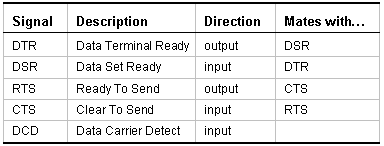


 |
 |
 |
Table of ContentsConnecting To Mosaic Controller RS422/485 Configuration Jumpers Protocol Configuration and Direction Control Registers Overview of the Software Device Driver Functions Installing the UART Module Driver Software Using the Driver Code with Forth UART Direction Control in a Multitasking System C Demonstration Program (in pdf) |
UART Wildcard User GuideModem Handshaking SignalsMost users of the UART Wildcard implement direct computer-to-computer communications via a serial cable. In these cases, hardware handshaking signals are typically not required. Rather, frequent polling or software-controlled handshaking by means of the "XON" and "XOFF" characters serves to ensure that the receiving computer is not overwhelmed by the incoming data stream. Some applications, however, require the use of hardware handshaking signals that enable the sender and receiver to signal their readiness to send and receive data. Communication over a telephone link via an RS232 modem is a prime example of such an application. The UART Wildcard implements five handshaking signals defined by the RS232 protocol to support a modem connection on serial Channel 1. If these modem handshaking signals are enabled, serial Channel 2 cannot be used for independent RS232 communications; however, it can still be used for RS422 or RS485. DTR, DSR, RTS, and CTS are handshaking signals that can be set and checked by the application software to control the flow of data. These signals are buffered by a single chip that can be powered down by the Set_Protocols function if the handshaking signals are not in use. DCD is an input from the modem that becomes active when an incoming data stream is detected on the phone line. DCD shares the RS232 receiver for serial channel 2; thus, Channel 2 cannot be configured for RS232 if the modem configuration is selected for Channel 1. The protocol initialization software function Set_Protocols is smart enough to detect an invalid protocol specification, returning an error parameter if it is attempted. The supported modem signals are listed in Table 1-3. Table 1-3 Modem Handshaking Signals  All of the signals listed in Table 1-3 are "active low". That is, when active they are at a logic low (0 volts) at the UART chip, which corresponds to a positive voltage on the RS232 cable. The Glossary includes functions that control and monitor the signals listed in Table 1-3. |
Home|Site Map|Products|Manuals|Resources|Order|About Us
Copyright (c) 2006 Mosaic Industries, Inc.
Your source for single board computers, embedded controllers, and operator interfaces for instruments and automation